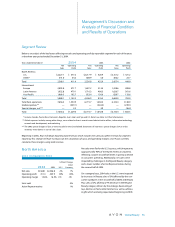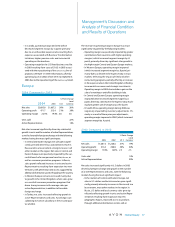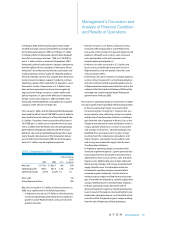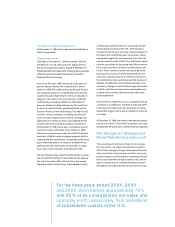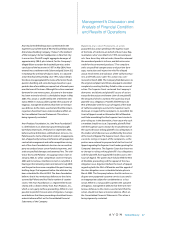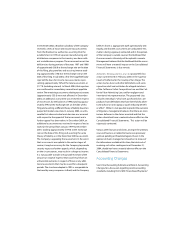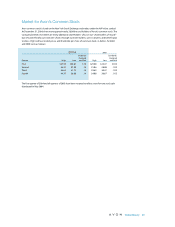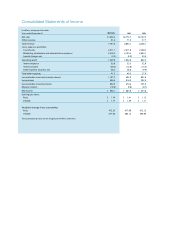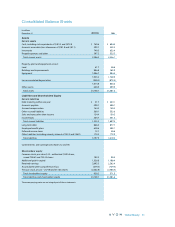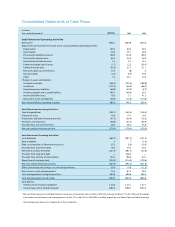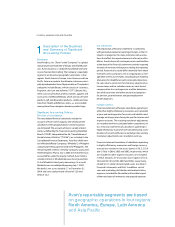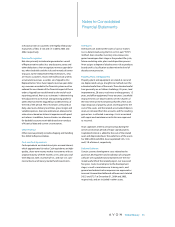Avon 2004 Annual Report Download - page 24
Download and view the complete annual report
Please find page 24 of the 2004 Avon annual report below. You can navigate through the pages in the report by either clicking on the pages listed below, or by using the keyword search tool below to find specific information within the annual report.
Management’s Discussion and
Analysis of Financial Condition
and Results of Operations
through operational means. Since Avon uses foreign
currency rate-sensitive and interest rate-sensitive instru-
ments to hedge a certain portion of its existing and fore-
casted transactions, Avon expects that any loss in value
for the hedge instruments generally would be offset by
increases in the value of the underlying transactions.
Avon does not enter into derivative financial instru-
ments for trading or speculative purposes, nor is Avon a
party to leveraged derivatives. The master agreements
governing Avon’s derivative contracts generally contain
standard provisions that could trigger early termination
of the contracts in certain circumstances, including if
Avon were to merge with another entity and the credit-
worthiness of the surviving entity were to be “materially
weaker” than that of Avon prior to the merger.
Interest Rate Risk
Avon’s long-term, fixed-rate borrowings are subject to
interest rate risk. Avon uses interest rate swaps, which
effectively convert the fixed rate on the debt to a float-
ing interest rate, to manage its interest rate exposure.
At December 31, 2004 and 2003, Avon held interest rate
swap agreements that effectively converted approxi-
mately 70% and 90%, respectively, of its outstanding
debt of $918.0 and $1,121.8, respectively, to a variable
interest rate based on LIBOR.
Avon’s long-term borrowings and interest rate swaps
were analyzed at year-end to determine their sensitivity
to interest rate changes. Based on the outstanding bal-
ance of all these financial instruments at December 31,
2004, a hypothetical 50 basis point change (either an
increase or a decrease) in interest rates prevailing at that
date, sustained for one year, would not represent a
material potential change in fair value, earnings or cash
flows. This potential change was calculated based on
discounted cash flow analyses using interest rates
comparable to Avon’s current cost of debt.
Foreign Currency Risk
Avon operates globally, with manufacturing and distri-
bution facilities in various locations around the world.
For the three years ended 2004, 2003 and 2002, the
Company derived approximately 70% and 90% of its
consolidated net sales and operating profit, respectively,
from operations of subsidiaries outside of the U.S. In
addition, as of December 31, 2004 and 2003, these sub-
sidiaries comprised approximately 60% of the Com-
pany’s consolidated total assets.
Avon is exposed to changes in financial market condi-
tions in the normal course of its operations, primarily
due to international businesses and transactions
denominated in foreign currencies and the use of vari-
ous financial instruments to fund ongoing activities.
Avon’s diversified global portfolio of businesses has
demonstrated that the effects of weak economies and
currency fluctuations in certain countries may be offset
by strong results in others. Fluctuations in the value of
foreign currencies cause U.S. dollar-translated amounts to
change in comparison with previous periods. Accordingly,
Avon cannot project the possible effect of such fluctua-
tions upon translated amounts or future earnings. This
is due to the large number of currencies, intercompany
transactions, hedging-related activities entered into in an
attempt to minimize the impact of exchange rate changes
on financial results, and the fact that all foreign currencies
do not react in the same manner against the U.S. dollar.
Nevertheless, during 2004, the U.S. dollar continued to
weaken against most major currencies. If this trend con-
tinues, it is expected to have a favorable impact on the
translation of the Company’s overseas results.
Avon uses foreign currency forward contracts and
options to hedge portions of its forecasted foreign cur-
rency cash flows resulting from intercompany royalties,
intercompany loans, and other third-party and inter-
company foreign currency transactions where there is
a high probability that anticipated exposures will mate-
rialize. These contracts have been designated as cash
flow hedges. At December 31, 2004, the primary cur-
rencies for which Avon has net underlying foreign cur-
rency exchange rate exposure are the Argentine peso,
Brazilian real, British pound, Chinese renminbi, the
Euro, Japanese yen, Mexican peso, Philippine peso, Pol-
ish zloty, Russian ruble and Venezuelan bolivar.
Avon uses foreign currency forward contracts and for-
eign currency denominated debt to hedge the foreign
currency exposure related to the net assets of certain of
its foreign subsidiaries.
Avon also enters into foreign currency forward contracts
and options to protect against the adverse effects that
exchange rate fluctuations may have on the earnings of
its foreign subsidiaries. These derivatives do not qualify
for hedge accounting and, therefore, the gains and
losses on these derivatives have been recognized in
earnings each reporting period.
Global Beauty 45


